

Nowadays, rose has been well known to the world as the national flower of the United Kingdom of Great Britain and Northern Ireland. Actually, apart from the UK, many European countries and the United States also regard rose as national floral emblem. It is said that people take roses to express their endearment, and because there are thorns on the stems, which could also be served as metaphor of solemnity.
However, as we all know, the status that rose has achieved in Britain demands a step by step evolution process. And since the United Kingdom is made up of England, Scotland, Northern Ireland and Wales, it comes very naturally that their representative flowers are not same. Specifically, the Representative flower of Northern Ireland is the shamrock, a three-leafed plant similar to clover, which is said to be the traditional symbol of St. Patrick’s Day. Patrick’s followers adopted the custom of wearing a shamrock on his feast day. And for Wales, the daffodil is usually considered to be the national emblem and is traditionally worn on St. David’s Day. It is St. David that advises the Welsh to wear daffodil to distinguish friends from foes during the battle against the Saxons. But unlike Wales, Scotland treats thistle, being used as a symbol of defense in fifteenth century, as national flower. The Scottish Bluebell is also seen as the flower of Scotland.
And as for England, rose has been adopted as national flower since the time of the Wars of the Roses---civil wars between the royal House of Lancaster (whose emblem was a red rose) and the royal House of York (whose emblem was a white rose). The final victory went to a claimant of the Lancastrian party, Henry Tudor, who defeated the last Yorkist king, Richard III, at the Battle of Bosworth Field. After assuming the throne as Henry VII, he married Elizabeth of York, the eldest daughter and heiress of Edward IV, and these two kinds of roses combine into that is half white and half red, called Tudor Rose, though it is an artificial flower and hardly exist in the nature. Finally, the parliament passed a bill of regarding rose as the national flower on September.23, 1986.
Not only that, the rose has a place in the western traditional culture. According to a Christian legend, Jesus was betrayed and crucified, and his blood drops in the soil, then the roses grown under cross. And other tradition has it that in order to save her lover, Venus ran in a hurry, rose thorns tore her hands and feet, thus the blood red roses. Subsequently, people regard the red rose as a token of love. In Greek mythology, Rose is a masterpiece created by the Zeus who used it to boast his ability. Besides, the ancient Persian poet once said in his poems: He mixes rose with a snake, pigeon, honey, the Dead Sea water, apple, soil, and pinch a woman. British people put the elements of the rose in the film because they love roses. For example, in film “The Slipper and the Rose”, rose is not just a seasoning agent for love, but also often linked to the fairy tale story. What’s more, "The Nightingale and the Rose" is a famous fairy tale written by Oscar Wilde, a famous British writer, and Madonna also writes fairy tale "the Rose of England" for her own daughter, which has broken the record of the release of book "Harry potter" all over the world. It seems that the fairy tales about rose have beyond counted, and the rose itself has become a plot in stories.
The national flower refers to their domestic famous flowers as characterization of country, signifying territorial integrity of the country, a long history of civilization and splendid culture, as well as the spirit of national unity.It reflects the love of the motherland and the strong national feelings, which can enhance national cohesion. Britain is arguably the oldest representative democracy in the world with a relatively moderate political reform process, which corresponds to the rose’s symbol of peace, love and friendship. Britain’s neutralizing national character distinguishes the UK from countries like France or the United States whose histories are marked by periods of sudden, and often violent, change.
Roses have been appreciated throughout centuries and are considered one of the most popular and widely cultivated flowers in the world today, with over 150 species and more than 20,000 hybrids available. We hope that roses can pass such a message across the world: Love and loyalty, cooperation and peace, friendship and strength, encouragement and hope, courage and dedication. We hope that even those children in the slums can also see the hope through a petal of flower, and to pursue the sun of brilliant tomorrow. We also hope that perhaps one day we can love each other just as the dialogue in “the Nightingale and the Rose”: "if you give me some red roses, I would like to dance with you."






Comment